Jefferson Memorial
The Jefferson Memorial is a presidential memorial built in Washington, D.C. between 1939 and 1943 under the sponsorship of President Franklin D. Roosevelt. Roosevelt thought that it was a suitable memorial to the Founding Fathers of the United States and to Thomas Jefferson, the principal author of the United States Declaration of Independence and the founder of the Democratic-Republican Party.
Jefferson Memorial | |
U.S. National Memorial | |
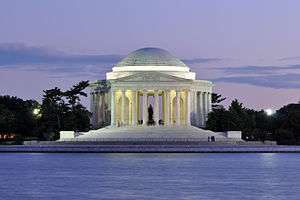 | |
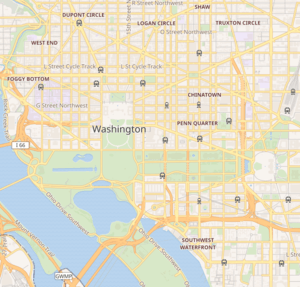  | |
| Location | Washington, D.C. |
|---|---|
| Coordinates | 38°52′53″N 77°02′12″W |
| Area | 79,758 square feet (7,409.8 m2) |
| Built | 1939–1943 |
| Architect | John Russell Pope; Eggers & Higgins |
| Architectural style | Classical Revival |
| Visitation | 2,312,726 (2005) |
| Website | Thomas Jefferson Memorial |
| NRHP reference No. | 66000029 |
| Significant dates | |
| Added to NRHP | October 15, 1966[1] |
| Designated NMEM | April 13, 1943[2] |
The neoclassical building is situated in West Potomac Park on the shore of the Potomac River. It was designed by John Russell Pope and built by Philadelphia contractor John McShain. Construction began in 1939 and was completed in 1943. The bronze statue of Jefferson was added in 1947.[3] Pope made references to the Roman Pantheon and to Jefferson's own design for the rotunda at the University of Virginia. The Jefferson Memorial and the White House form one of the main anchor points in the area of the National Mall in D.C. The Washington Monument was intended to be located at the intersection of the White House and the site for the Jefferson Memorial, but soft swampy ground required that it be situated to the east.[4]
The Jefferson Memorial is managed by the National Park Service of the Department of the Interior under its National Mall and Memorial Parks division. In 2007, it was ranked fourth on the "List of America's Favorite Architecture" by the American Institute of Architects.[5]
History
It became apparent that the site was well suited for another high-profile memorial since it sat directly south of the White House. By 1901 the Senate Park Commission, better known as the McMillan Commission, had proposed placing a Pantheon-like structure on the site hosting "the statues of the illustrious men of the nation, or whether the memory of some individual shall be honored by a monument of the first rank may be left to the future"; no action was ever taken by Congress on this issue.[3]
The completion of the Tidal Basin Inlet Bridge in 1908 helped to facilitate the recreational usage of East and West Potomac Parks. In 1918, large liquid-chlorine dispensers were installed under the bridge to treat the water and make the Tidal Basin (also known as Twining Lake) suitable for swimming. The Tidal Basin Beach, on the site of the future Memorial, opened in May 1918 and operated as a "Whites Only" facility until 1925, when it was permanently closed to avoid the question of racial integration.[6]
A design competition was held for a memorial to Theodore Roosevelt in 1925. The winning design was submitted by John Russell Pope and consisted of a half-circle memorial situated next to a circular basin. The plan was never funded by Congress and was not built.[3]
The Memorial's chance came in 1934 when President Franklin Roosevelt, an admirer of Jefferson, in large part because of the book on Jefferson of his friend Claude G. Bowers, inquired to the Commission of Fine Arts about the possibility of erecting a memorial to Jefferson, including it in the plans for the Federal Triangle project, which was under construction at the time. Later the same year, Congressman John J. Boylan jumped off FDR's starting point and urged Congress to create the Thomas Jefferson Memorial Commission. Boylan was appointed the Commission's first chairman and Congress eventually appropriated $3 million for a memorial to Jefferson.[3]
The Commission chose John Russell Pope as the architect in 1935. Pope was also the architect of the National Archives Building and original (west) building of the National Gallery of Art. He prepared four different plans for the project, each on a different site. One was on the Anacostia River at the end of East Capitol Street; one at Lincoln Park; one on the south side of the National Mall across from the National Archives; and one situated on the Tidal Basin, directly south of the White House. The Commission preferred the site on the Tidal Basin mainly because it was the most prominent site and because it completed the four-point plan called for by the McMillan Commission (Lincoln Memorial to the Capitol; White House to the Tidal Basin site). Pope designed a very large pantheon-like structure, to sit on a square platform, and to be flanked by two smaller, rectangular, colonnaded buildings.[3]
Construction
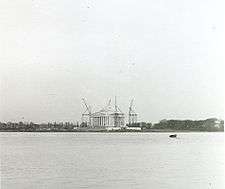
Construction began on December 15, 1938, and the cornerstone was laid on November 15, 1939, by Franklin Roosevelt. By this point Pope had died (1937) and his surviving partners, Daniel P. Higgins and Otto R. Eggers, took over construction of the memorial. The design was modified at the request of the Commission of Fine Arts to a more conservative design. The memorial cost approximately $3 million to construct.[7]
Construction commenced amid significant opposition. The Commission of Fine Arts never actually approved any design for the memorial and even published a pamphlet in 1939 opposing both the design and site of the memorial. In addition, many Washingtonians opposed the site because it was not aligned with L'Enfant's original plan. Finally, many well-established elm and cherry trees, including rare stock donated by Japan in 1912,[8] were destined for removal under the original plan. Construction continued amid the opposition,[3] and although the chaining of women protestors to cherry trees, and the negative press toward the memorial that resulted, caused President Roosevelt considerable dismay, such protests ultimately helped limit the projected footprint of the new memorial, so that it would peacefully co-exist with the spring-blooming cherry orchard flanking and abutting it.[8]
In 1939, the Memorial Commission hosted a competition to select a sculptor for the planned statue in the center of the memorial. They received 101 entries and chose six finalists. Of the six, Rudulph Evans was chosen as the main sculptor and Adolph A. Weinman was chosen to sculpt the pediment relief situated above the entrance.[3]
Landscape architect Frederick Law Olmsted Jr. designed the memorial landscape. The Olmsted planting plan installed at the time of construction featured a simple design within a circular driveway; primarily evergreen trees with limited flowering trees and shrubs. The design was perceived as too thin, so white pines were added and some other plantings took place before the dedication in 1943. Many changes to Olmsted's plans occurred in the 1970s, while 1993 and 2000 restorations have attempted to restore integrity to Olmsted's altered design.[9] President Roosevelt ordered trees to be cut so that the view of the memorial from the White House would be enhanced; additional tree pruning was completed to create an unobstructed view between the Jefferson Memorial and Lincoln Memorial.[9]
The Jefferson Memorial was officially dedicated by President Roosevelt on April 13, 1943, the 200th anniversary of Jefferson's birthday. At that time, Evans' statue had not yet been finished. Due to material shortages during World War II, the statue that was installed at the time was a plaster cast of Evans' work painted to look like bronze. The finished bronze statue was installed in 1947, having been cast by the Roman Bronze Works of New York.[3]
As a National Memorial it was administratively listed on the National Register of Historic Places on October 15, 1966.[1][10]
Description
Exterior
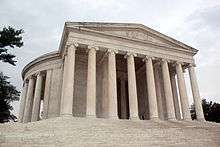
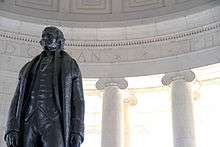
The Jefferson Memorial is composed of circular marble steps, a portico, a circular colonnade of Ionic order columns, and a shallow dome. The building is open to the elements. It has a diameter of approximately 165 feet (50 m).[7]
The memorial is constructed of white Imperial Danby marble from Vermont, which rests upon a series of granite and marble-stepped terraces. A flight of granite and marble stairs and platforms, flanked by granite buttresses, lead up from the Tidal Basin to a portico with a triangular pediment.
The pediment features a sculpture by Adolph Alexander Weinman depicting the Committee of Five, the five members of the drafting committee of the Declaration of Independence. Beside Jefferson, the members of this committee were John Adams, Benjamin Franklin, Roger Sherman, and Robert Livingston. A cornice with an egg and dart molding surrounds this pediment, below which is a plain frieze.[9]
Interior
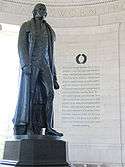
The interior of the memorial has a 19 feet (5.8 m) tall, 10,000 lb (4,500 kg) bronze statue[11] of Jefferson by the sculptor Rudulph Evans.[11] The statue was added four years after the dedication. Most prominent are the words which are inscribed in a frieze below the dome: "I have sworn upon the altar of God eternal hostility against every form of tyranny over the mind of man."[12] This sentence is taken from a letter written by Jefferson on September 23, 1800,[13] to Dr. Benjamin Rush wherein he defends the constitutional refusal to recognize a state religion.
On the panel of the southwest interior wall are excerpts from the Declaration of Independence, written in 1776:[14]
We hold these truths to be self-evident: that all men are created equal, that they are endowed by their Creator with certain inalienable rights, among these are life, liberty, and the pursuit of happiness, that to secure these rights governments are instituted among men. We ... solemnly publish and declare, that these colonies are and of right ought to be free and independent states ... And for the support of this declaration, with a firm reliance on the protection of divine providence, we mutually pledge our lives, our fortunes, and our sacred honor.
The inscription uses the word "inalienable", as in Jefferson's draft, rather than "unalienable", as in the published Declaration.[15]
On the panel of the northwest interior wall is an excerpt from the 1777 Virginia Statute for Religious Freedom, except for the last sentence, which is taken from a letter of August 28, 1789, to James Madison:[14][16]
Almighty God hath created the mind free ... All attempts to influence it by temporal punishments or burthens ... are a departure from the plan of the Holy Author of our religion ... No man shall be compelled to frequent or support any religious worship or ministry or shall otherwise suffer on account of his religious opinions or belief, but all men shall be free to profess and by argument to maintain, their opinions in matters of religion. I know but one code of morality for men whether acting singly or collectively.
The quotes from the panel of the northeast interior wall are from multiple sources. The first sentence, beginning "God who gave ...", is from A Summary View of the Rights of British America.[17] The second, third and fourth sentences are from Notes on the State of Virginia.[18] The fifth sentence, beginning "Nothing is more ...", is from Jefferson's autobiography.[19] The sixth sentence, beginning "Establish the law ...", is from a letter of August 13, 1790, to George Wythe.[20] The final sentence is from a letter of January 4, 1786, to George Washington:[14][21]
God who gave us life gave us liberty. Can the liberties of a nation be secure when we have removed a conviction that these liberties are the gift of God? Indeed I tremble for my country when I reflect that God is just, that his justice cannot sleep forever. Commerce between master and slave is despotism. Nothing is more certainly written in the book of fate than these people are to be free. Establish the law for educating the common people. This it is the business of the state to effect and on a general plan.
The inscription on the panel of the southeast interior wall is redacted and excerpted from a letter of July 12, 1816, to Samuel Kercheval:[14][22]
I am not an advocate for frequent changes in laws and constitutions. But laws and institutions must go hand in hand with the progress of the human mind. As that becomes more developed, more enlightened, as new discoveries are made, new truths discovered and manners and opinions change, with the change of circumstances, institutions must advance also to keep pace with the times. We might as well require a man to wear still the coat which fitted him when a boy as civilized society to remain ever under the regimen of their barbarous ancestors.
Location
The site of the monument is in West Potomac Park, in Washington, D.C., on the shore of the Potomac River Tidal Basin, and is enhanced with the massed planting of Japanese cherry trees, a gift from the people of Japan in 1912.[23]
The monument is not as prominent in popular culture as other buildings and monuments in Washington, D.C., possibly due to its location well removed from the National Mall and the Washington Metro. The Jefferson Memorial hosts many events and ceremonies each year, including memorial exercises, the Easter Sunrise Service, and the annual National Cherry Blossom Festival.[23]
Gallery
 Main entry
Main entry Portico ceiling
Portico ceiling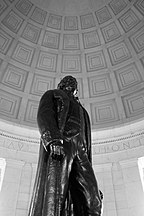 Bronze statue and dome ceiling
Bronze statue and dome ceiling Dome ceiling and frieze
Dome ceiling and frieze Exterior columns
Exterior columns- "We Hold These Truths"
- "God Who Gave Us Life"
 "I Am Not an Advocate for Frequent Changes ..."
"I Am Not an Advocate for Frequent Changes ..." "Almighty God Hath Created the Mind Free ..."
"Almighty God Hath Created the Mind Free ..." Thousands of people visit the Memorial each year.
Thousands of people visit the Memorial each year. Thomas Jefferson Memorial
Thomas Jefferson Memorial Jefferson Memorial sunset
Jefferson Memorial sunset Washington Monument in background
Washington Monument in background Tidal Basin view, March 2016
Tidal Basin view, March 2016
See also
References
- "National Register Information System". National Register of Historic Places. National Park Service. January 23, 2007.
- Shalett, Sidney. "President Roosevelt Dedicates a National Memorial to Thomas Jefferson." New York Times. 14 April 1943,1. Retrieved on October 7, 2008
- Documentation of the Jefferson Memorial. Office of the Historic American Buildings Survey/Historic American Engineering Record (HABS/HAER), of the National Park Service. September 1994. Library of Congress. Retrieved October 13, 2008
- Torres, Louis (1984), "To the immortal name and memory of George Washington": The United States Army Corps of Engineers and the Construction of the Washington Monument (PDF), Washington, D.C.: US Government Printing Office, archived from the original (PDF) on June 24, 2016, retrieved April 11, 2018
- America's Favorite Architecture. American Institute of Architecture. Archived May 8, 2015, at the Wayback Machine. Retrieved October 14, 2008
- "Historic Structures Report, Tidal Basin Inlet Bridge, Washington DC, May 2, 1986; Chapter 1 "Historical Background and Issues" page 34.
- "Thomas Jefferson Memorial--Presidents: A Discover Our Shared Heritage Travel Itinerary". www.nps.gov. Retrieved November 1, 2019.
- Hendrix, Steve (March 30, 2019). "'Stop the massacre!': When women chained themselves to Washington's cherry trees". The Washington Post. Retrieved April 19, 2019.
- "Thomas Jefferson Memorial Features". National Park Service. Retrieved November 11, 2016.
- Donald C. Pfanz (January 12, 1981). "National Register of Historic Places Inventory-Nomination: Thomas Jefferson Memorial". National Park Service. Cite journal requires
|journal=(help) - No Author. "Model of building for Jefferson Memorial." New York Times. March 7, 1943, 13-13. Retrieved October 7, 2008
- interview Archived June 28, 2014, at the Wayback Machine October 16, 2012, with Stephen Colbert, Playboy.com
- "Archived copy". Archived from the original on December 10, 2006. Retrieved August 2, 2004.CS1 maint: archived copy as title (link)
- "Quotations on the Jefferson Memorial". Thomas Jefferson's Monticello. monticello.org. Retrieved August 11, 2012.
- "Unalienable / Inalienable". ushistory.org. Archived from the original on October 2, 2012. Retrieved August 11, 2012.
- Jefferson, Thomas (1904–1905). "TO JAMES MADISON 1, Aug. 28, 1789". In Paul Leicester Ford (ed.). The Works of Thomas Jefferson. 5 (Federal ed.). New York and London: G.P. Putnam's Sons. Retrieved August 11, 2012.
- Jefferson, Thomas (1905). Andrew A. Lipscomb and Albert Ellery Bergh (ed.). The Writings of Thomas Jefferson. 1. p. 211.
- Paul Leicester Ford, ed. (1904–1905). The Works of Thomas Jefferson. 4, Notes On Virginia, QUERY XVIII, The particular customs and manners that may happen to be received in that State?. New York and London: G.P. Putnam's Sons. pp. 82–84. Retrieved August 11, 2012.
- Jefferson, Thomas (1904–1905). "AUTOBIOGRAPHY 1743–1790". In Paul Leicester Ford (ed.). The Works of Thomas Jefferson. 1 (Federal ed.). New York and London: G.P. Putnam's Sons. p. 77. Retrieved August 11, 2012.
- Jefferson, Thomas. "Letter Wythe "A CRUSADE AGAINST IGNORANCE" To George Wythe Paris, August 13, 1786 1786081". Electronic Text Center, University of Virginia Library. Archived from the original on December 15, 2012. Retrieved August 11, 2012.
- Jefferson, Thomas. "Thomas Jefferson letter to George Washington, 4 January 1786". FamilyTales. Retrieved August 11, 2012.
- Jefferson, Thomas Teaching American History Archived May 2, 2013, at the Wayback Machine, Teaching American History
- "Cherry Blossom History". National Park Service. Retrieved January 13, 2009.
![]()
Bibliography
- Bedford, Steven McLeod, John Russell Pope: Architect of Empire, Rizzoli International Publications, Inc., New York, NY 1998
- Goode, James M. The Outdoor Sculpture of Washington D.C., Smithsonian Institution Press, Washington D.C. 1974
- The National Parks: Index 2001–2003. Washington: U.S. Department of the Interior.
External links
| Wikimedia Commons has media related to Jefferson Memorial. |
- Trust for the National Mall: Thomas Jefferson Memorial
- Official NPS website: Thomas Jefferson Memorial
- "Nothing is more certainly written in the book of fate..." in its original context
- Three-dimensional rendering of Jefferson Memorial (without plugin; in English, Spanish, German)
- Jefferson Memorial History and Fun Facts
